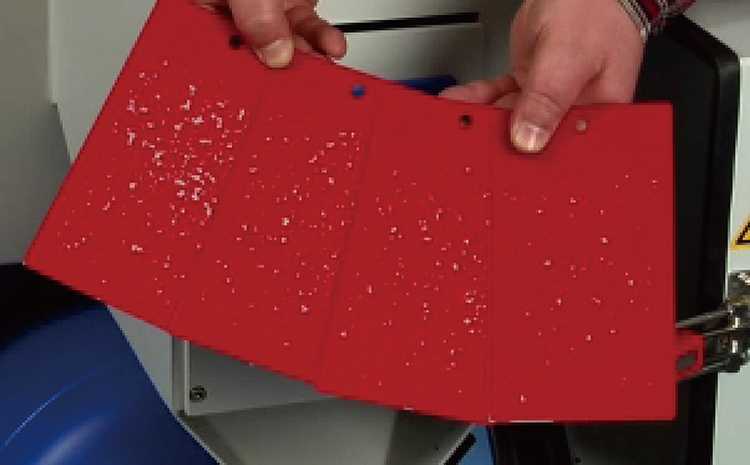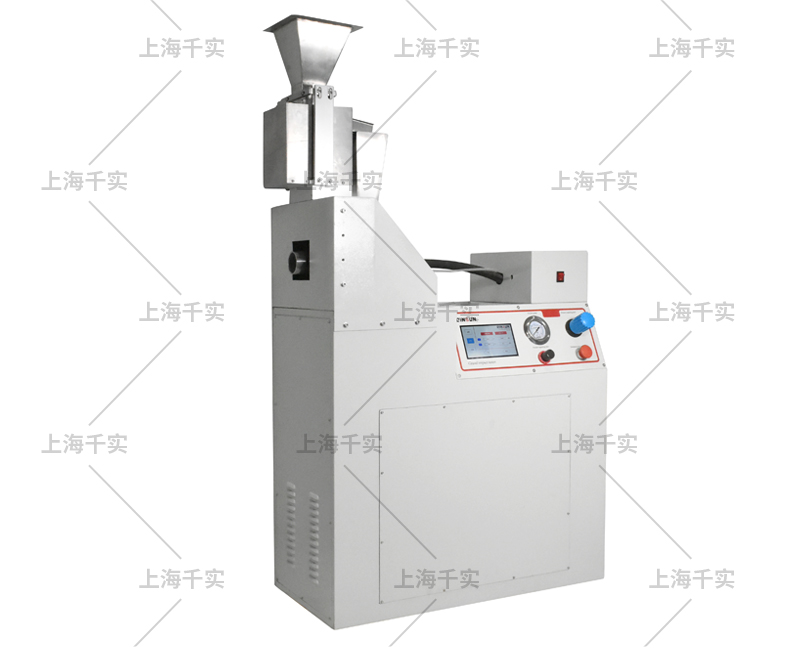Stone hammer blow testing instrument mainly simulates the actual driving condition of the vehicle, and the individual parts of the vehicle body are often impacted by heavy objects such as sliding material and pavement gravels. Thus, the products are damaged. The product damage degree is determined by injection Angle, injection pressure, number of injection, airflow speed, the specification and quality of steel shot or gravel, impact duration and test instrument.
Work Principles
A certain weight of gravel is bounced into the feeder by vibration. Due to the vacuum formed by the high speed air flow in the lower part of the feeder, the collision medium is sucked into the ejection gun assembly, and then is shot into the test sample by the jet stream. After the medium hit the test target, the medium falls into the gravel collecting box. The test machine causes a large number of steel balls or rubble with sharp edges to hit the sample surface in a short time. The whole experiment is carried out under a controlled temperature. After the impact is finished, the loose coating is removed with adhesive tape to reveal the residual stone strike marks on the sample, which can be used to judge the performance of the resistance to stone impact by analyzing the damage degree of the sample.
Standards
SAE J400,VDA 621427,ISO 20567-1,ASTM D3170,GMW14668-3.4.9,Peugeot/Citroen D241312,Chrysler 463PB-52-01 、Chrysler 463PB-39-01,Mazda MES MN 601C ,Toyota,Nissan,Ford BI 157-04、Ford BI 157-05.
The new gravel impact tester is assembled by standard component and equipped with easy handling accessories, achieving gravel impact against all the main standard automotive materials on this one machine. It is the only instrument in China that adopts the universal adjustment device, and the 0-180 impact angle can be adjusted arbitrarily.( the so-called mufti-functional instruments produced by other manufacturers is actually equipped with different angel collision boxes ). The first disadvantage is that customers need constantly change collision boxes with different angles. It has a lot of trouble to make replacement and the collision boxes of different angles will cover a large area. The second disadvantage is that the collision boxes are not complete enough with different angles to meet customers need for subsequently adding the required impact angles.
impact window of the test bench:300*300 mm,(impact window size of the test bench is larger than the size produced by other manufacturers .the instrument procuced by our company is adjustable and fixable by the ambulant Support frame according to the different styles and size of the product)
The colliding box is constructed in a whole, and the entire hitting mechanism is in the interior of the crash box, including the test sample. Safe and reasonable design, excluding different specifications of the sample (especially the arc-shaped sample) due to lax, resulting in the impact of the media splash out.
the instrument Uses a large volume of gas storage tank of which the volume achieve to 170L. (30% larger than any domestic manufacturers, the impact of more stable pressure).
The main standard components of gravel impact tester : gun assembly, collision chamber and specimen holder.
The gravel impact tester Quickly carry out the loading and unloading of the specimen and equipped with an external type of gravel collection box .it is convenient and practical.
Display style: operating instrument for the touch screen, easy to operate at a glance. (Other home is digital or pointer type)
Working pressure range: 0 ~ 5.0 kgf / cm2 / grade 1.6 (according to the actual customer pressure to adjust the situation, up to 8.0kgf / cm2)
Spray guns: Standard SAE and VDA each one (replacement is extremely convenient).
Feeding method: automatic feeding (feed speed adjustable)
Safety device: The safety power switch will automatically shut down the test when the collision chamber door is open or when the collision chamber is not installed (other home does not have this safety measure and function). Equipment leakage protection, pressure overpressure, pressure relief protection.
Equipment size approx: 1800 L * 950 W * 1500H mm
Technical indicators:
EMC immunity: EN 50082-2 (1995)
EMC radioactivity: meets EN 55011 (1997) level requirements
air:
Gas consumption: up to 80psi, flow rate of 100 cubic feet per minute of gas 5-10 seconds (VDA standard requires less)
Compressed air: 80psi pressure, flow rate of 100 cubic feet per minute
Compressed air pipe diameter: SAE test: 3/4 inch (19mm) or greater
VDA test: 1/2 inch or greater
Air tank volume: 30 gallons
Operating temperature: -30 ℃ --- 40 ℃
Maximum relative humidity: humidity of 31 ℃ when the humidity of 80%, when the temperature reaches 40 ℃ when the humidity line reduced to 50%
Pollution control: Level 2 of environmental protection
Sound pressure rating: about 130dBA
Altitude: 2000m
Continuous operation: for continuous operation
Shot barrel diameter:
SAE J400: 2.07 in. (52.6mm)
VDA: 11.42 inches (290mm)
Flat Inspection Sample Size:
4X6 inch (101.6 x152.4mm)
4X8 inch (101.6 x203.2mm)
4X12 inch (101.6 x304.8mm)
Thickness up to 7/16 inch (11.11mm)
It is also possible to accept a sample with a maximum width of 4.125 inches (104.8 mm)
Optional accessories:
In order to meet the diverse requirements of customers, special configuration of a variety of accessories:
1. Pneumatic fixture (only 90 degree impact)
2. Impact angle adapter: 30o 45o 60o 90o
3. Impact particles: 4 ~ 5mm sharp GH diamante steel Grit, just pill
Features
· The ejection nozzle is free and fast, complying with standards such as VDA and SAE.
· The touch screen setting makes the test process more convenient and concise.
· Plate type test sample angle can meet the requirements of 0-90 ° settings at 15 ° intervals.
· Continuous or intermittent operation can perform multiple tests in a short time.
· Feed rate is adjusted by electromagnetic vibration feeder.
· The large volume compressed air storage tank keep pressure and flow constant while controlling the pressure through control valve in the ejection nozzle.
· It is equipped with various safety protection measures: safety power-off device, air pressure safety protection device, which conforms to European CE and EMC certification.
Assessment Method
1) Stick the adhesive tape to the surface of the sample coating, apply uniform force for tight attachment to the surface of the sample and avoid creating air bubbles. Then pull up the tape.
2) The tape is attached to the surface of the sample coating, and it is applied to the surface of the sample with uniform force to avoid the bubbling. Then pull up the tape from the opposite direction of 1).
3) Repeat the steps of 1) and 2) until the damaged coating completely comes off.
4) At this pint, you can accurately count the damage points for assessment.
5) Cover the transparent grille on the sample, count the number of coating damage points (except the impact marks) in 101.6mm x 101.6 mm area and confirm the size of the damage pints.
Technical Parameters
| Items | VDA | SAE |
| Dimension | 1750x500x1220mm | 1600x500x1250mm |
| Net weight | About 100Kg | About 100Kg |
| Compressed air port | 6-10bar,13mm connecting pipe | 8-10bar,19mm connecting pipe |
| Input pressure limit | 5bar | Over 7.8bar |
| Working pressure | 0-3bar/grade 1 | 0-6bar controlled by sensor with 0.5% accuracy |
| Feed time | 5~30s adjustable | 4~30s adjustable |
| Display | 8 digit backlit LCD, height 11.5mm | 8 digit backlit LCD, height 11.5mm |
| Power | 230V/50Hz,Other power sources are also available | 230V/50Hz,Other power sources are also available |
| Impact medium | 4-5mm sharp steel balls, GH Diamond 06032 | Cobblestones, in accordance with ASTMD 3170 |


评论
发表评论